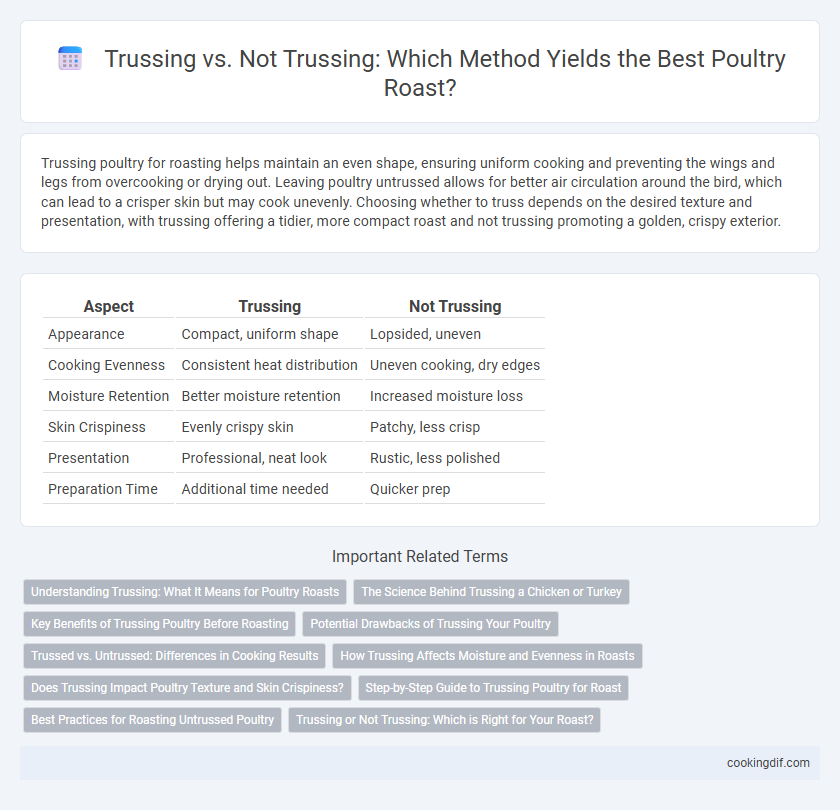Trussing poultry for roasting helps maintain an even shape, ensuring uniform cooking and preventing the wings and legs from overcooking or drying out. Leaving poultry untrussed allows for better air circulation around the bird, which can lead to a crisper skin but may cook unevenly. Choosing whether to truss depends on the desired texture and presentation, with trussing offering a tidier, more compact roast and not trussing promoting a golden, crispy exterior.
Table of Comparison
| Aspect | Trussing | Not Trussing |
|---|---|---|
| Appearance | Compact, uniform shape | Lopsided, uneven |
| Cooking Evenness | Consistent heat distribution | Uneven cooking, dry edges |
| Moisture Retention | Better moisture retention | Increased moisture loss |
| Skin Crispiness | Evenly crispy skin | Patchy, less crisp |
| Presentation | Professional, neat look | Rustic, less polished |
| Preparation Time | Additional time needed | Quicker prep |
Understanding Trussing: What It Means for Poultry Roasts
Trussing poultry involves tying the bird with kitchen twine to secure the legs and wings close to the body, promoting even cooking and a uniform shape. This technique helps retain moisture by preventing exposed extremities from drying out, resulting in juicier meat and crispier skin. Not trussing allows for more airflow around the bird, which can produce a different texture but may lead to uneven cooking or drier edges.
The Science Behind Trussing a Chicken or Turkey
Trussing a chicken or turkey ensures even heat distribution by keeping wings and legs close to the body, which promotes uniform cooking and prevents over-drying of exposed extremities. This technique minimizes moisture loss, enhancing juiciness by reducing surface area exposed to hot air in the oven. Scientific studies show trussed poultry retains shape better and cooks more consistently, resulting in improved texture and appearance.
Key Benefits of Trussing Poultry Before Roasting
Trussing poultry before roasting ensures even cooking by keeping the bird compact and preventing the wings and legs from spreading out, which helps maintain moisture and tenderness. It promotes better heat circulation around the meat, resulting in a uniformly golden, crispy skin and enhanced flavor. Trussing also improves presentation by maintaining the shape of the bird, making it ideal for serving.
Potential Drawbacks of Trussing Your Poultry
Trussing poultry can restrict even heat circulation, potentially leading to uneven cooking and undercooked sections. The tight binding may also cause the breast meat to overcook while the legs and thighs remain underdone due to limited exposure to heat. Furthermore, improper trussing can result in a loss of crispy skin texture, diminishing the overall roast quality.
Trussed vs. Untrussed: Differences in Cooking Results
Trussing poultry ensures even cooking by securing the wings and legs close to the body, which helps maintain moisture and a uniform shape during roasting. Untrussed birds tend to cook faster but risk uneven heat distribution, leading to drier extremities and irregular browning. Choosing between trussed and untrussed affects texture, juiciness, and presentation of the final roast.
How Trussing Affects Moisture and Evenness in Roasts
Trussing poultry helps retain moisture by keeping the bird compact, which minimizes exposure to air and reduces drying during roasting. It promotes even cooking by ensuring the legs and wings stay close to the body, preventing overcooking of thinner extremities and undercooking of thicker sections. Without trussing, uneven heat exposure can lead to inconsistent texture and dryness in parts of the roast.
Does Trussing Impact Poultry Texture and Skin Crispiness?
Trussing poultry helps maintain a compact shape, promoting even cooking and juicier meat by minimizing exposed surface area. Without trussing, the bird's limbs may spread, leading to uneven heat distribution and potentially drier texture in extremities. Skin crispiness tends to improve with trussing due to consistent skin tension during roasting, preventing sagging and facilitating uniform browning.
Step-by-Step Guide to Trussing Poultry for Roast
Trussing poultry for roasting ensures even cooking and maintains a compact shape, preventing wing and leg flapping that can lead to uneven heat exposure. Begin by placing kitchen twine under the bird's neck, cross the legs, and tie them securely to keep the shape intact, then tuck the wings under the body to avoid burning. Proper trussing locks in juices and promotes uniform browning, enhancing the texture and flavor of the roast.
Best Practices for Roasting Untrussed Poultry
Roasting untrussed poultry preserves natural airflow around the bird, promoting even cooking and crispier skin by allowing heat to circulate freely. Leaving the bird untrussed reduces the risk of undercooked areas, especially in the cavity, and enhances the roasting process by enabling fat to render uniformly. For optimal results, position the wings tucked under the body and secure loose skin without tightly binding the legs to maintain structural integrity and improve flavor development.
Trussing or Not Trussing: Which is Right for Your Roast?
Trussing poultry ensures even cooking by securing wings and legs close to the body, which helps retain moisture and maintain an attractive shape. Not trussing promotes crispier skin by allowing air to circulate freely around the bird, enhancing browning and texture. Choosing between trussing or not depends on your desired presentation and texture preferences for the roast.
Trussing vs not trussing for poultry roast Infographic

 cookingdif.com
cookingdif.com